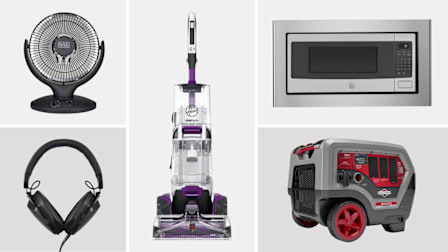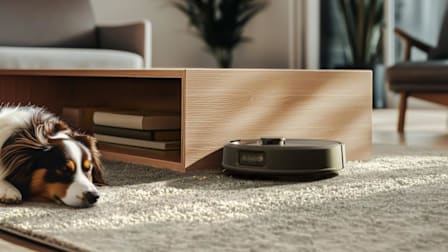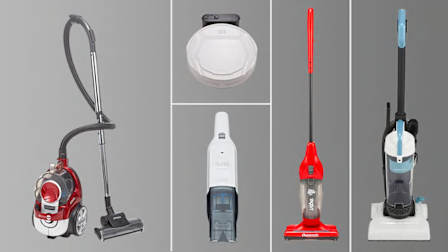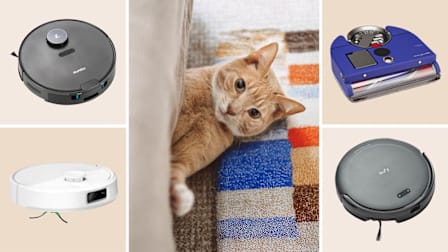Best Robotic Vacuums for Hardwood Floors
Consumer Reports' tests reveal the top-rated robovacs for bare floors
When you shop through retailer links on our site, we may earn affiliate commissions. 100% of the fees we collect are used to support our nonprofit mission. Learn more.
Robot vacuums autonomously pick up debris of all sorts, including crumbs and pet hair, maneuvering through hard-to-reach places like under a sofa or a bed. But our tests show that how well they clean depends on the type of flooring they’re sent out to sweep.
In our robotic vacuum lab, we measure how well each model is able to remove surface debris from bare floors (hardwood and laminate). We also gauge each one’s ability to navigate the nooks and crannies of a room, as well as how adequately it cleans the edges and corners. It’s worth noting that even those robotic vacuums earning high marks don’t quite stand up to the power of upright or canister vacuums. But they’re still a great option for pickups in between full vacuum sessions.
CR’s top five robot vacuums for hardwood flooring, listed below in alphabetical order, also happen to be some of the best robovacs in our ratings. Some of these models are also mops, but water can be damaging to hardwood floors, so save that function for areas of your home that have vinyl or tile flooring. For complete test results and even more options, CR members can access our robotic vacuum ratings, and anyone can check out our vacuum cleaner buying guide to learn more about how robotic vacuums compare with other types of vacuum cleaners.
The WiFi-enabled Eufy RoboVac X8 performs excellently at cleaning bare floors as well as navigating test areas and picking up pet hair. It’s also stellar at cleaning edges and corners, but our testers found it has a tendency to scatter debris. This budget-friendly model has a lithium-ion battery and a one-sided brush, and it comes with an extra filter, a filter-cleaning tool, and a docking station. As a brand, Eufy robot vacuums earn favorable marks for predicted reliability and owner satisfaction in our member surveys.
The iRobot Roomba Combo j9+ receives solid performance scores across the board in CR’s tests, earning an excellent score for cleaning bare floors and a very good score for carpet. It has smart mapping technology as well as avoidance technology to help it move around household obstacles like cords. Once the robot is docked, a vacuum in the docking station automatically sucks the contents from the bin into an enclosed disposable bag in the base. This vac also has mopping capabilities, but unlike the Combo i5 and Combo j5+, you don’t have to swap out the bin for mopping because it can vacuum and mop simultaneously. It’s dirt bin, though, is one of the smallest of the robovacs we tested.
Although the Roborock S8 Pro Ultra is priced on the higher end, it has a bunch of perks. For instance, once the bot is docked, a vacuum in the docking station automatically sucks the contents from the bin into the base. It also features WiFi connectivity and performs superbly at cleaning carpet, bare floors, and pet hair, as well as navigating under furniture and around obstacles. This model is equipped with a mopping system, and Roborock claims it’s self-washing and self-drying. That said, it’s one of the noisier models we’ve tested and has one of the smallest dirt bins.
How CR Tests Robotic Vacuums
We test each vacuum’s ability to pick up dirt on carpet and bare floors. To test pickup on bare floors, our technicians spread 0.75 gram of sand over laminate flooring in a 4x5-foot framed test area and measure the amount the vacuum picks up in a 10-minute period.
We also use a two-part test to see how effective robot vacuums are at cleaning carpets. For surface cleaning, our technicians disperse 20 grams of cereal, 30 grams of rice, and 20 grams of yellow peas across a 4x5-foot framed test area of medium-pile carpet. Then they measure how much of the debris is captured during a 10-minute period.
For embedded dirt, technicians embed 75 grams of flour across a section of test carpet, let the vacuum run in the area for 3 minutes, and then weigh the amount of flour it picked up. Human hair is embedded into the same section of the test carpet. Technicians time how long it takes for the vacuum to pick up the hair and weigh the amount that’s in the dustbin and the brush roll.
Our testers also rate robovacs on ease of use, which includes factors such as the size of the dustbin, whether the vacuum has a handle for carrying, how easy it is to clean the brush roll, whether the vacuum scatters debris, and whether you can schedule it for routine cleaning. We also assess robovacs on data privacy and security, scoring them on more than 70 indicators using The Digital Standard. And like our ratings for other household appliances, Consumer Reports assesses each vacuum brand’s owner satisfaction and predicted reliability based on our member surveys.

































